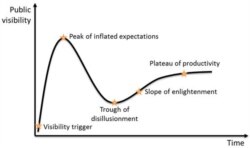Will Kyrgyzstan's new government go the way of the previous one, which was driven from power by protests that turned violent in April? One theory concerning the popular acceptance of technology could provide a clue.
Hype Cycle Theory was developed in 1995 by the information-technology research and advisory firm Gartner to explain how technological innovations gain popularity and evolve from fads into institutions.
It's a simple theory with wide applicability. In recent years it's been used to predict the growth of electronic products and web-based services like the iPhone, Facebook, and Twitter. If adapted carefully, it should be useful even for governments.
The theory states that every new technology will usually move through five phases.
In the first phase, the technology, newly introduced and advertised by its seller, experiences a "visibility trigger," very rapidly gaining media attention. Soon, everybody in the general public has heard about it. Think of Napster circa 2000.
In the second phase, media attention and public curiosity in the new technology reaches a fever pitch. But the overenthusiasm leads to unrealistic expectations, which eventually peak. This moment is the "peak of inflated expectations." Think of Twitter during the protests in Iran during the summer of 2009.
In the third phase, visibility and excitement decline, sometimes quickly, as the technology proves unable to meet expectations. Media coverage may turn negative or simply cease, and public curiosity dissipates. The technology may even become unfashionable, as was the fate of the social network Friendster in the West. This moment, which is critical, is called the "trough of disillusionment."
The technology can only survive the trough if its owners and/or some of its users remain committed. These devotees experiment with the technology's inner workings, developing new capabilities, all the while quietly expanding its reach away from media attention or public awareness. This slow, silent increase is called the "slope of enlightenment." The iPhone is currently at this phase.
Those technologies that can command such loyalty and energy eventually enter a fifth phase, essentially a revival, called the "plateau of productivity." A lot can happen here: the cycle could repeat itself -- this seems to be the pattern for Facebook, if not the Internet itself -- or the technology embarks upon a long, slow, self-reinforcing growth, like Friendster in Asia (obviously, the preferred situation).
Kyrgyzstan's Angry 'Owners'
In retrospect, one can see that many companies and consumers abandon products well before the plateau of productivity (and hence, maximized profitability) because unmet expectations lead to negative press, bad sales predictions, and disappointment among management and users. So, the keys to long-term survival and success are commitment, endurance, and the willingness to tinker.
Now, substitute "technology" for "government" and "owners" and "users" for "the people" and "the politicians" (although if we think in terms of government services, the real users are the people). Kyrgyzstan's two uprisings in 2005 and 2010, which brought President Kurmanbek Bakiev to power and then kicked him out, respectively, can be understood as obeying the same pattern as new technology.
Consider: a visibility trigger leads to overenthusiasm and eventually unrealistic expectations, inevitably peaking before declining, slowly in the case with Bakiev, evidently quite meteorically in the case of Roza Otunbaeva, into the trough of disillusionment. (On a side note, to what extent Kyrgyzstan's revolutions have been "user-generated," i.e., manufactured by politicians, is a hot debate.)
The analogy, though, has to be adapted after this point. The hype cycle might be disrupted if the trough isn't properly navigated. In a wealthy and stable society like Britain, bad navigation would result in snap parliamentary elections. Unfortunately, in Kyrgyzstan's case, it would probably mean civil war.
Otunbaeva's government now has essentially two options:
(a) The Autocratic Option. They can decide to regulate the hype cycle by tightening security measures, consolidating political activity in preapproved hands, and suppressing all competing initiatives. This was the option chosen by Bakiev after bloody protests in Bishkek in 2006.
The danger of this option is patently obvious, at least to outside observers: The owners may and probably will retaliate, as they did in 2010. The likelihood is almost certain if idealistic or opportunistic users, unafraid of destabilization in the pursuit of radical reform or personal gain, can tap into the proprietary rage.
(b) The Democratic Option. They can decide to accept the hype cycle by addressing the owners' disillusionment, while doing rear-guard actions to co-opt or offset dangerous users. This has been the option so far chosen by Otunbaeva.
However, this option is likely to meet strong opposition from those who stand to lose from it. For example, right now many fingers are pointing at Bakiev's network as the culprits behind June's tragic ethnic clashes. The key for Otunbaeva's government, then, as with a new technology, will be commitment, endurance, and flexibility.
Only Way Forward
Arguably, every new and uncertain government undergoes its own internal hype cycle. October's parliamentary elections could therefore be a critical moment in the emotional makeup of Otunbaeva's government. They must be careful not to expect too much.
Now, if the trough of disillusionment can be navigated, the next question concerns the quality of the slope of enlightenment. Unlike in technology, politics must work with existing conditions; there is no code that can be unlocked and rewritten as one sees fit. Nevertheless, statecraft is about creating opportunities.
Bakiev was able to successfully navigate his trough phase in 2006, but clearly his slope phase was one commandeered by a small clique at the exclusion of not only the owners but many users, too. In retrospect, that his plateau of productivity resulted in stagnation, decline, and eventual overthrow comes as no surprise.
So far, Otunbaeva's slope of enlightenment has been flawed but transparent and collaborative -- for example, the successful referendum in June. Survival and success lie in a sustainable and just plateau of productivity. That means political stability, implementing democratic values, and the real existence of viable development opportunities for all citizens of Kyrgyzstan.
In the end, that's a pattern worth its weight in iPhones.
The views expressed in this commentary are the authors' own and do not necessarily reflect those of RFE/RL
Hype Cycle Theory was developed in 1995 by the information-technology research and advisory firm Gartner to explain how technological innovations gain popularity and evolve from fads into institutions.
It's a simple theory with wide applicability. In recent years it's been used to predict the growth of electronic products and web-based services like the iPhone, Facebook, and Twitter. If adapted carefully, it should be useful even for governments.
The theory states that every new technology will usually move through five phases.
In the first phase, the technology, newly introduced and advertised by its seller, experiences a "visibility trigger," very rapidly gaining media attention. Soon, everybody in the general public has heard about it. Think of Napster circa 2000.
In the second phase, media attention and public curiosity in the new technology reaches a fever pitch. But the overenthusiasm leads to unrealistic expectations, which eventually peak. This moment is the "peak of inflated expectations." Think of Twitter during the protests in Iran during the summer of 2009.
In the third phase, visibility and excitement decline, sometimes quickly, as the technology proves unable to meet expectations. Media coverage may turn negative or simply cease, and public curiosity dissipates. The technology may even become unfashionable, as was the fate of the social network Friendster in the West. This moment, which is critical, is called the "trough of disillusionment."
The technology can only survive the trough if its owners and/or some of its users remain committed. These devotees experiment with the technology's inner workings, developing new capabilities, all the while quietly expanding its reach away from media attention or public awareness. This slow, silent increase is called the "slope of enlightenment." The iPhone is currently at this phase.
Those technologies that can command such loyalty and energy eventually enter a fifth phase, essentially a revival, called the "plateau of productivity." A lot can happen here: the cycle could repeat itself -- this seems to be the pattern for Facebook, if not the Internet itself -- or the technology embarks upon a long, slow, self-reinforcing growth, like Friendster in Asia (obviously, the preferred situation).
Kyrgyzstan's Angry 'Owners'
In retrospect, one can see that many companies and consumers abandon products well before the plateau of productivity (and hence, maximized profitability) because unmet expectations lead to negative press, bad sales predictions, and disappointment among management and users. So, the keys to long-term survival and success are commitment, endurance, and the willingness to tinker.
Now, substitute "technology" for "government" and "owners" and "users" for "the people" and "the politicians" (although if we think in terms of government services, the real users are the people). Kyrgyzstan's two uprisings in 2005 and 2010, which brought President Kurmanbek Bakiev to power and then kicked him out, respectively, can be understood as obeying the same pattern as new technology.
Consider: a visibility trigger leads to overenthusiasm and eventually unrealistic expectations, inevitably peaking before declining, slowly in the case with Bakiev, evidently quite meteorically in the case of Roza Otunbaeva, into the trough of disillusionment. (On a side note, to what extent Kyrgyzstan's revolutions have been "user-generated," i.e., manufactured by politicians, is a hot debate.)
The analogy, though, has to be adapted after this point. The hype cycle might be disrupted if the trough isn't properly navigated. In a wealthy and stable society like Britain, bad navigation would result in snap parliamentary elections. Unfortunately, in Kyrgyzstan's case, it would probably mean civil war.
Otunbaeva's government now has essentially two options:
(a) The Autocratic Option. They can decide to regulate the hype cycle by tightening security measures, consolidating political activity in preapproved hands, and suppressing all competing initiatives. This was the option chosen by Bakiev after bloody protests in Bishkek in 2006.
The danger of this option is patently obvious, at least to outside observers: The owners may and probably will retaliate, as they did in 2010. The likelihood is almost certain if idealistic or opportunistic users, unafraid of destabilization in the pursuit of radical reform or personal gain, can tap into the proprietary rage.
(b) The Democratic Option. They can decide to accept the hype cycle by addressing the owners' disillusionment, while doing rear-guard actions to co-opt or offset dangerous users. This has been the option so far chosen by Otunbaeva.
However, this option is likely to meet strong opposition from those who stand to lose from it. For example, right now many fingers are pointing at Bakiev's network as the culprits behind June's tragic ethnic clashes. The key for Otunbaeva's government, then, as with a new technology, will be commitment, endurance, and flexibility.
Only Way Forward
Arguably, every new and uncertain government undergoes its own internal hype cycle. October's parliamentary elections could therefore be a critical moment in the emotional makeup of Otunbaeva's government. They must be careful not to expect too much.
Now, if the trough of disillusionment can be navigated, the next question concerns the quality of the slope of enlightenment. Unlike in technology, politics must work with existing conditions; there is no code that can be unlocked and rewritten as one sees fit. Nevertheless, statecraft is about creating opportunities.
Bakiev was able to successfully navigate his trough phase in 2006, but clearly his slope phase was one commandeered by a small clique at the exclusion of not only the owners but many users, too. In retrospect, that his plateau of productivity resulted in stagnation, decline, and eventual overthrow comes as no surprise.
So far, Otunbaeva's slope of enlightenment has been flawed but transparent and collaborative -- for example, the successful referendum in June. Survival and success lie in a sustainable and just plateau of productivity. That means political stability, implementing democratic values, and the real existence of viable development opportunities for all citizens of Kyrgyzstan.
In the end, that's a pattern worth its weight in iPhones.
The views expressed in this commentary are the authors' own and do not necessarily reflect those of RFE/RL











